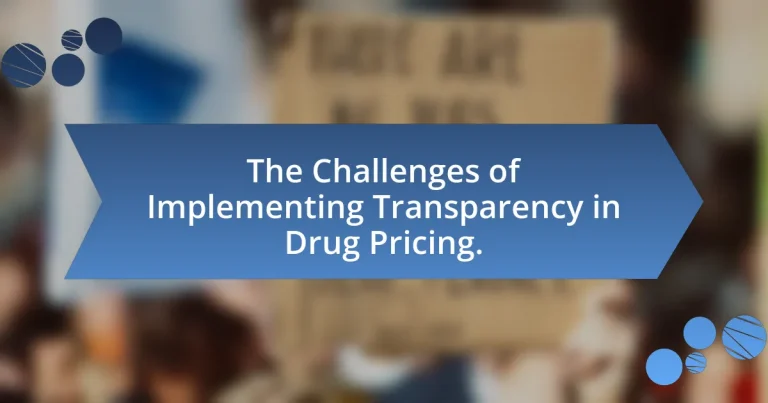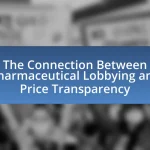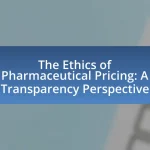The article addresses the challenges of implementing transparency in drug pricing, highlighting complex pricing structures, lack of standardized data, and stakeholder resistance as significant obstacles. It emphasizes the importance of transparency for enabling informed decisions by consumers, healthcare providers, and policymakers, which can lead to reduced healthcare costs and improved patient access to medications. The article also explores the role of technology, data analytics, and legislative measures in enhancing transparency, while discussing the potential outcomes of improved pricing visibility, including better health outcomes and increased competition in the pharmaceutical market.
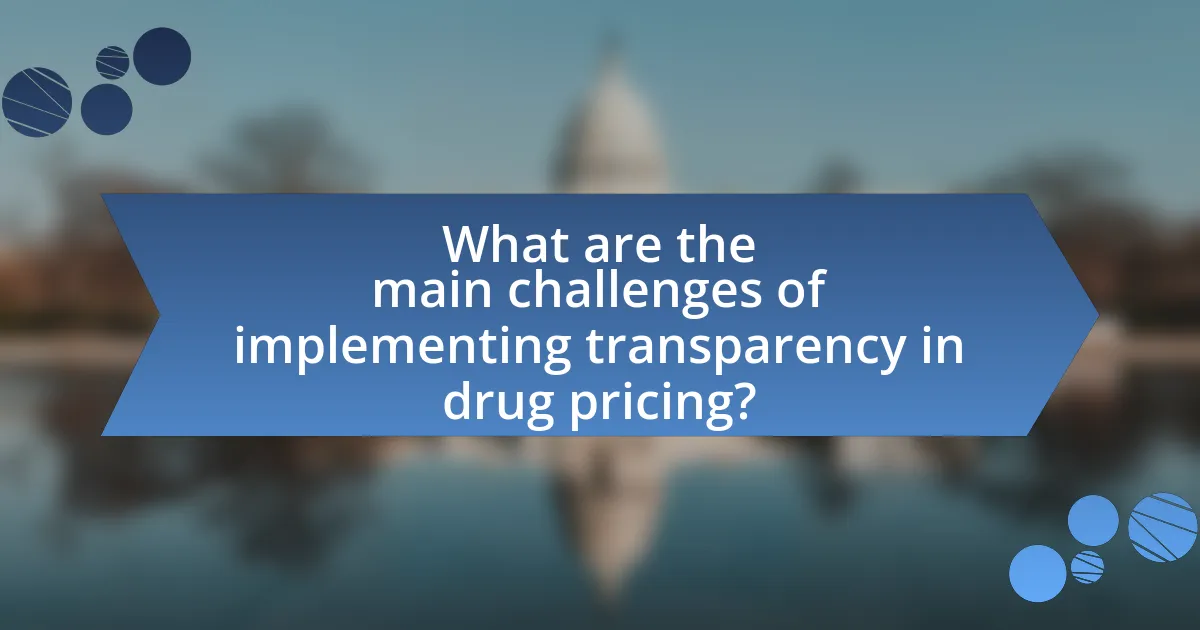
What are the main challenges of implementing transparency in drug pricing?
The main challenges of implementing transparency in drug pricing include complex pricing structures, lack of standardized data, and resistance from stakeholders. Complex pricing structures, such as rebates and discounts, obscure the actual costs of drugs, making it difficult for consumers and healthcare providers to understand pricing. The lack of standardized data across different entities, including manufacturers, insurers, and pharmacies, leads to inconsistencies in pricing information, complicating efforts to achieve transparency. Additionally, stakeholders, including pharmaceutical companies and insurers, may resist transparency initiatives due to concerns about competitive disadvantage and profit margins, as evidenced by ongoing debates in legislative contexts regarding drug pricing reforms.
Why is transparency in drug pricing important?
Transparency in drug pricing is important because it enables consumers, healthcare providers, and policymakers to make informed decisions regarding medication costs and accessibility. When drug pricing is transparent, it allows for better competition among pharmaceutical companies, which can lead to lower prices and improved affordability for patients. According to a 2020 study published in the Journal of the American Medical Association, increased transparency in drug pricing can reduce overall healthcare spending by fostering price competition and encouraging the use of lower-cost alternatives. This evidence underscores the critical role that transparency plays in promoting fair pricing practices and enhancing the overall efficiency of the healthcare system.
How does transparency impact patient access to medications?
Transparency significantly enhances patient access to medications by providing clear information about drug prices and availability. When patients have access to transparent pricing, they can make informed decisions regarding their treatment options, which can lead to increased adherence to prescribed therapies. A study published in the Journal of Managed Care & Specialty Pharmacy found that when drug prices are disclosed, patients are more likely to choose lower-cost alternatives, thereby improving their access to necessary medications. Furthermore, transparency can foster competition among pharmaceutical companies, potentially driving down prices and increasing the overall availability of medications in the market.
What role does transparency play in healthcare costs?
Transparency plays a crucial role in healthcare costs by enabling patients to make informed decisions about their care and fostering competition among providers. When healthcare pricing is transparent, patients can compare costs and quality, leading to more cost-effective choices. A study by the Health Care Cost Institute found that price transparency can reduce healthcare spending by up to 7% as consumers become more price-sensitive and seek lower-cost options. Additionally, transparency encourages providers to offer competitive pricing, which can further drive down costs in the healthcare market.
What obstacles do stakeholders face in achieving transparency?
Stakeholders face several obstacles in achieving transparency in drug pricing, primarily due to complex pricing structures, lack of standardized data, and regulatory challenges. Complex pricing structures, including rebates and discounts, obscure the actual costs of drugs, making it difficult for stakeholders to understand and communicate pricing effectively. Additionally, the absence of standardized data across different entities leads to inconsistencies in pricing information, hindering efforts to provide clear and comparable data. Regulatory challenges, such as varying state laws and federal regulations, further complicate the ability to implement uniform transparency measures. These factors collectively impede stakeholders’ efforts to achieve meaningful transparency in drug pricing.
How do pharmaceutical companies resist transparency initiatives?
Pharmaceutical companies resist transparency initiatives primarily through lobbying efforts and legal challenges. These companies often engage in extensive lobbying to influence legislation and regulations that promote transparency, aiming to protect proprietary information and maintain competitive advantages. For instance, the Pharmaceutical Research and Manufacturers of America (PhRMA) has actively opposed measures that would require disclosure of drug pricing and cost structures, arguing that such transparency could undermine innovation and lead to higher prices. Additionally, companies may utilize legal tactics to challenge transparency laws, citing concerns over trade secrets and intellectual property rights, which can delay or obstruct the implementation of such initiatives.
What regulatory challenges hinder transparency in drug pricing?
Regulatory challenges that hinder transparency in drug pricing include complex pricing structures, lack of standardized reporting requirements, and confidentiality agreements between manufacturers and payers. These complexities create barriers for stakeholders to access clear pricing information. For instance, the absence of uniform regulations means that drug prices can vary significantly across different markets and contracts, making it difficult for consumers and healthcare providers to understand actual costs. Additionally, confidentiality clauses often prevent the disclosure of negotiated prices, further obscuring the true cost of medications. According to a 2020 report by the U.S. Government Accountability Office, these factors contribute to a lack of clarity in drug pricing, which ultimately affects patient access and healthcare costs.
How does the lack of transparency affect consumers?
The lack of transparency in drug pricing negatively affects consumers by obscuring the true costs of medications, leading to confusion and mistrust. When consumers cannot easily access information about drug prices, they struggle to make informed decisions, often resulting in higher out-of-pocket expenses. A study by the Kaiser Family Foundation found that 72% of Americans believe that prescription drug prices are not transparent, which contributes to their inability to compare prices and seek more affordable options. This lack of clarity can also lead to unexpected financial burdens, as consumers may face higher costs than anticipated when purchasing medications.
What are the consequences of hidden drug prices for patients?
Hidden drug prices lead to significant financial burdens for patients, often resulting in unexpected out-of-pocket costs. Patients may avoid necessary medications due to uncertainty about prices, which can lead to worsened health outcomes. A study published in the Journal of the American Medical Association found that nearly 25% of patients reported not filling a prescription due to high costs, highlighting the direct impact of price opacity on medication adherence. Furthermore, hidden prices can exacerbate health disparities, as low-income patients are disproportionately affected by the inability to anticipate drug costs, leading to inequitable access to necessary treatments.
How does price opacity influence healthcare decisions?
Price opacity significantly influences healthcare decisions by creating uncertainty regarding the actual costs of medical services and medications. This lack of transparency leads patients to make uninformed choices, often resulting in delayed care or avoidance of necessary treatments due to fear of unexpected expenses. Research indicates that when patients are unaware of prices, they are less likely to seek care, which can exacerbate health issues and increase long-term costs. A study published in the Journal of Health Economics found that price transparency can lead to more competitive pricing and better decision-making among consumers, highlighting the importance of clear pricing in healthcare.
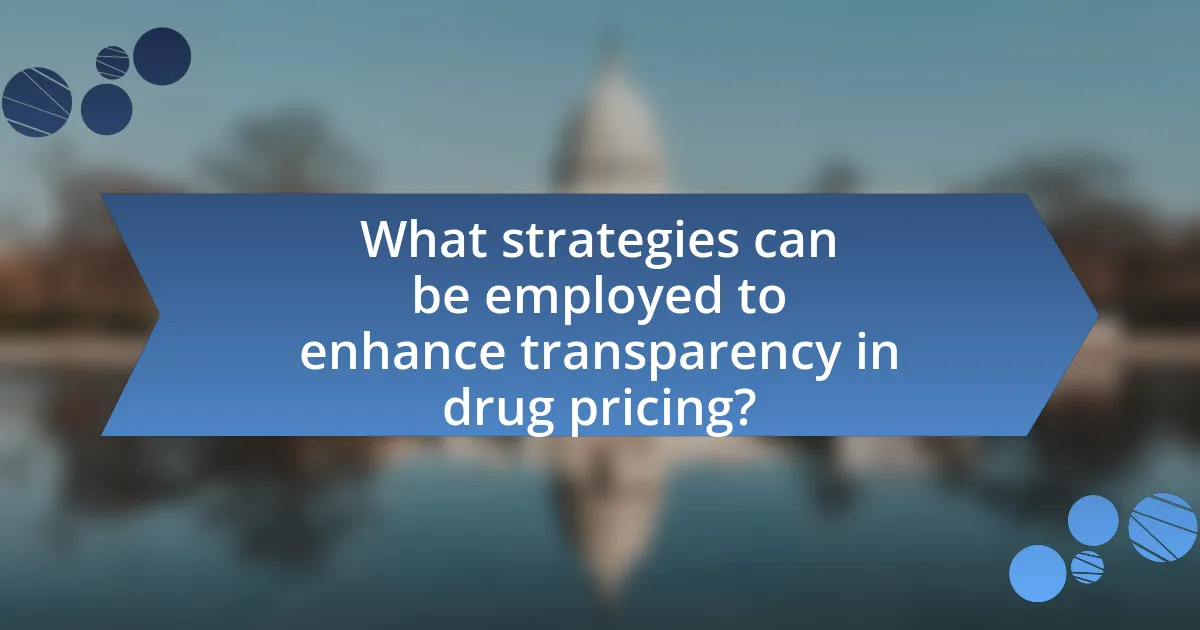
What strategies can be employed to enhance transparency in drug pricing?
To enhance transparency in drug pricing, implementing standardized pricing models and requiring disclosure of cost components are effective strategies. Standardized pricing models, such as value-based pricing, can provide a clear framework for consumers to understand the costs associated with medications. Additionally, requiring pharmaceutical companies to disclose the breakdown of costs, including research and development, manufacturing, and marketing expenses, allows stakeholders to see how prices are determined. Evidence from the 2021 report by the Institute for Clinical and Economic Review indicates that transparency in pricing can lead to more informed decision-making by patients and healthcare providers, ultimately fostering competition and potentially lowering prices.
How can legislation promote drug pricing transparency?
Legislation can promote drug pricing transparency by mandating that pharmaceutical companies disclose pricing information and the factors influencing those prices. For instance, laws can require manufacturers to provide detailed reports on production costs, research and development expenses, and pricing strategies. Such requirements can help consumers and healthcare providers make informed decisions, as evidenced by the implementation of California’s SB 17, which mandates drug price disclosures for certain medications. This law aims to enhance accountability and enable better market competition, ultimately leading to more affordable drug prices.
What successful examples of transparency legislation exist?
Successful examples of transparency legislation include the Affordable Care Act (ACA) in the United States, which mandates that hospitals publicly disclose their standard charges for services. This legislation has led to increased price transparency in healthcare, allowing consumers to make informed decisions. Additionally, the European Union’s Transparency Directive requires publicly traded companies to disclose financial information, enhancing corporate accountability and investor trust. These examples demonstrate how transparency legislation can effectively promote openness and accountability in various sectors.
How can policymakers ensure compliance with transparency laws?
Policymakers can ensure compliance with transparency laws by establishing clear regulations, implementing robust monitoring systems, and enforcing penalties for non-compliance. Clear regulations provide a framework that defines expectations for transparency in drug pricing, which is essential for accountability. Robust monitoring systems, such as regular audits and data reporting requirements, allow for ongoing assessment of compliance levels among pharmaceutical companies. Additionally, enforcing penalties for violations, such as fines or restrictions on market access, serves as a deterrent against non-compliance. For instance, the implementation of the Affordable Care Act included provisions that mandated price transparency, leading to increased compliance among healthcare providers and insurers.
What role do technology and data play in improving transparency?
Technology and data play a crucial role in improving transparency by enabling real-time access to information and facilitating data analysis. For instance, digital platforms allow stakeholders, including consumers and healthcare providers, to access drug pricing information, thereby reducing information asymmetry. According to a study by the Health Care Cost Institute, the use of data analytics in healthcare can lead to a 20% reduction in costs by identifying price discrepancies and promoting competitive pricing. Furthermore, blockchain technology enhances transparency by providing an immutable record of transactions, which can be particularly beneficial in tracking drug pricing and ensuring accountability in the supply chain.
How can data analytics help reveal drug pricing structures?
Data analytics can reveal drug pricing structures by analyzing large datasets to identify pricing patterns, discrepancies, and trends. By employing techniques such as regression analysis and machine learning, stakeholders can uncover the factors influencing drug prices, including manufacturing costs, market demand, and insurance reimbursement rates. For instance, a study published in the Journal of Managed Care & Specialty Pharmacy found that data analytics helped identify significant price variations for the same medication across different regions, highlighting the lack of pricing transparency. This analytical approach enables policymakers and healthcare providers to make informed decisions aimed at improving pricing transparency and reducing costs.
What technological solutions are available for price transparency?
Technological solutions available for price transparency in drug pricing include blockchain technology, data analytics platforms, and mobile applications. Blockchain technology enables secure and immutable records of drug prices, allowing stakeholders to access real-time pricing information and verify transactions. Data analytics platforms aggregate and analyze pricing data from various sources, providing insights into pricing trends and discrepancies. Mobile applications facilitate direct access to price information for consumers, enabling them to compare prices across different pharmacies. These solutions enhance visibility and accountability in drug pricing, addressing the challenges of transparency in the pharmaceutical industry.
How can stakeholders collaborate to foster transparency?
Stakeholders can collaborate to foster transparency by establishing open communication channels and sharing relevant data regarding drug pricing. This collaboration can involve pharmaceutical companies, healthcare providers, insurers, and regulatory bodies working together to create standardized reporting practices. For instance, the National Academy of Medicine emphasizes that transparency in drug pricing can be enhanced through shared databases that track pricing and cost-effectiveness, allowing stakeholders to make informed decisions. By collectively agreeing on metrics and methodologies for reporting, stakeholders can ensure that pricing information is accessible and understandable, thereby building trust and accountability in the drug pricing system.
What partnerships can enhance transparency efforts?
Partnerships between pharmaceutical companies, government agencies, and healthcare organizations can enhance transparency efforts in drug pricing. These collaborations can facilitate the sharing of pricing data, improve regulatory compliance, and foster public trust. For instance, initiatives like the Drug Pricing Transparency Initiative in the United States aim to bring together stakeholders to create standardized pricing disclosures, which can lead to more informed consumer choices and accountability in pricing practices. Such partnerships have been shown to reduce information asymmetry and promote fair pricing, ultimately benefiting patients and the healthcare system.
How can patient advocacy groups contribute to transparency initiatives?
Patient advocacy groups can contribute to transparency initiatives by actively promoting clear communication about drug pricing and advocating for policies that require disclosure of pricing information. These groups often gather and disseminate data on drug costs, helping to educate patients and the public about pricing structures and the factors influencing them. For instance, organizations like the National Patient Advocate Foundation have been instrumental in pushing for legislative changes that mandate price transparency, thereby empowering patients to make informed decisions regarding their healthcare. Their efforts can lead to increased accountability among pharmaceutical companies and healthcare providers, ultimately fostering a more transparent healthcare system.
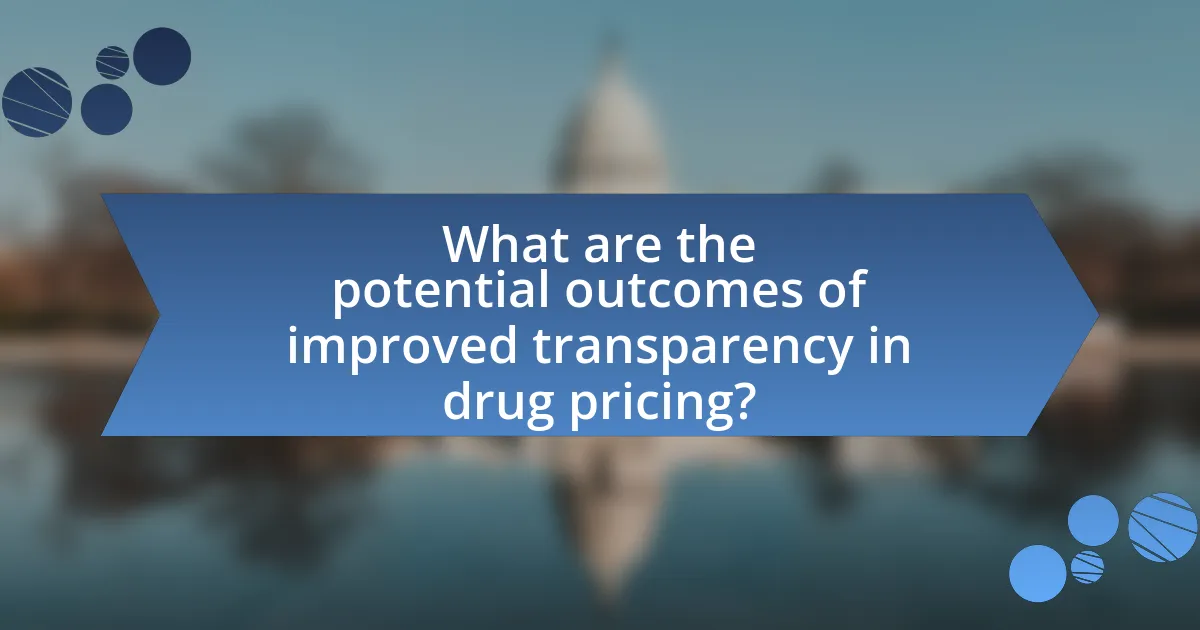
What are the potential outcomes of improved transparency in drug pricing?
Improved transparency in drug pricing can lead to reduced healthcare costs and increased competition among pharmaceutical companies. When drug prices are openly disclosed, consumers and healthcare providers can make more informed decisions, potentially driving down prices as companies compete for market share. A study published in the Journal of the American Medical Association found that states implementing price transparency laws saw a decrease in prescription drug prices by an average of 10%. Additionally, transparency can enhance trust in the healthcare system, as patients feel more empowered to question pricing and advocate for fair costs.
How might transparency affect drug pricing trends?
Transparency can significantly lower drug pricing trends by enabling consumers and healthcare providers to make informed decisions based on price comparisons. When drug prices are openly disclosed, competition among manufacturers increases, often leading to reduced prices as companies strive to attract buyers. A study by the National Bureau of Economic Research found that states implementing transparency laws saw a decrease in prices for certain medications, demonstrating that visibility into pricing can drive market dynamics. Additionally, transparency can empower patients to seek more affordable options, further influencing pricing strategies within the pharmaceutical industry.
What impact could transparency have on pharmaceutical innovation?
Transparency can significantly enhance pharmaceutical innovation by fostering trust and collaboration among stakeholders. When pharmaceutical companies openly share data on drug development processes, pricing, and clinical trial results, it encourages a more competitive environment that can lead to increased investment in research and development. For instance, a study published in the Journal of Health Economics found that transparency in pricing and outcomes can lead to a 20% increase in the number of new drug applications submitted to regulatory agencies. This openness not only helps in identifying effective treatments more quickly but also aligns the interests of patients, healthcare providers, and payers, ultimately driving innovation in the industry.
How can transparency lead to better health outcomes for patients?
Transparency can lead to better health outcomes for patients by enabling informed decision-making regarding treatment options and costs. When patients have access to clear information about drug pricing, they can compare alternatives, understand their financial responsibilities, and choose therapies that align with their health needs and budget. Research indicates that transparency in healthcare pricing can reduce overall costs and improve adherence to prescribed treatments, as patients are more likely to follow through when they understand the financial implications. For instance, a study published in the Journal of the American Medical Association found that price transparency initiatives led to a 7% increase in the use of lower-cost medications, ultimately enhancing patient outcomes by making effective treatments more accessible.
What best practices can be adopted for effective transparency implementation?
Effective transparency implementation in drug pricing can be achieved through several best practices. First, establishing clear communication channels between stakeholders, including pharmaceutical companies, healthcare providers, and patients, fosters understanding and trust. For instance, providing detailed breakdowns of drug costs and pricing structures can demystify pricing for consumers. Second, utilizing technology, such as blockchain, can enhance data integrity and accessibility, allowing for real-time tracking of drug prices and transactions. Research from the National Academy of Sciences indicates that transparency in pricing can lead to reduced healthcare costs and improved patient outcomes. Third, engaging in regular audits and assessments of pricing practices ensures compliance with transparency standards and identifies areas for improvement. These practices collectively contribute to a more transparent drug pricing system, ultimately benefiting all parties involved.
What steps should organizations take to ensure transparency in pricing?
Organizations should implement clear communication of pricing structures to ensure transparency in pricing. This involves providing detailed breakdowns of costs, including base prices, additional fees, and any discounts or rebates. By doing so, organizations can help consumers understand the total cost of products or services, which is essential in the context of drug pricing where complexities often obscure true costs. For instance, a study by the National Academy of Sciences highlights that transparent pricing can lead to more informed consumer choices and increased competition among providers, ultimately benefiting patients.
How can consumers advocate for greater transparency in drug pricing?
Consumers can advocate for greater transparency in drug pricing by actively participating in policy discussions, supporting legislation that mandates price disclosure, and utilizing platforms that promote price comparison. Engaging with lawmakers through petitions and public comments can influence the creation of policies aimed at transparency. For instance, the Affordable Care Act includes provisions that require health plans to disclose pricing information, demonstrating that consumer advocacy can lead to legislative changes. Additionally, joining or supporting organizations focused on healthcare reform can amplify consumer voices and push for systemic changes in drug pricing transparency.
